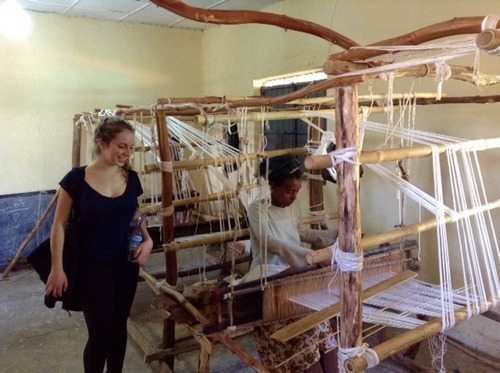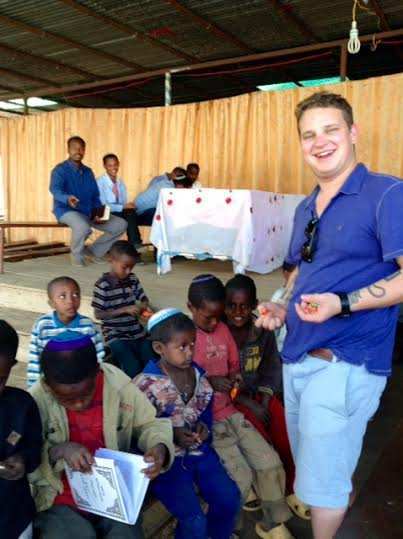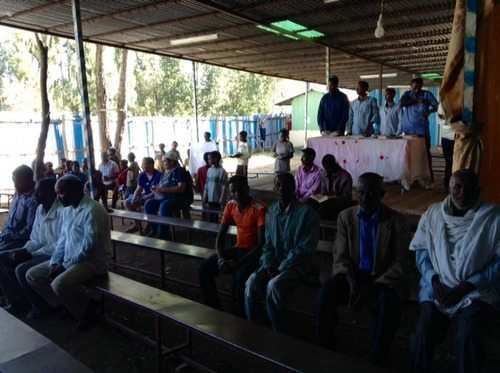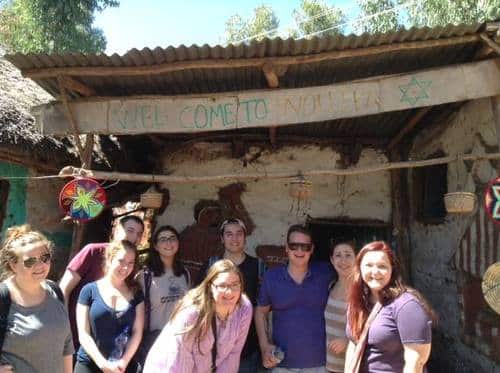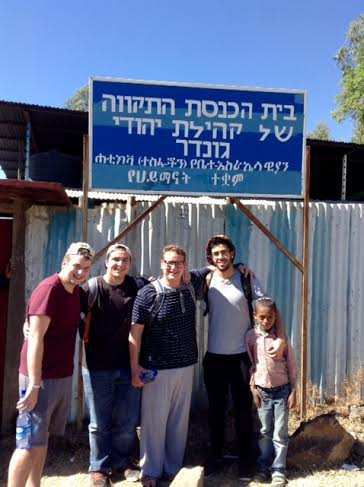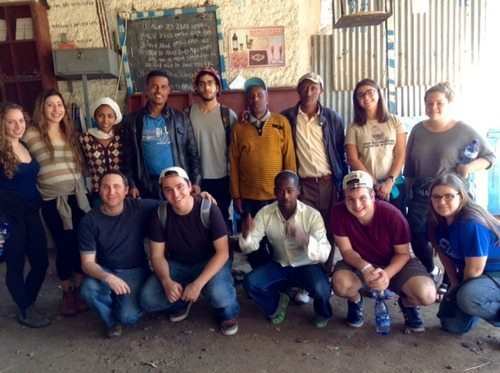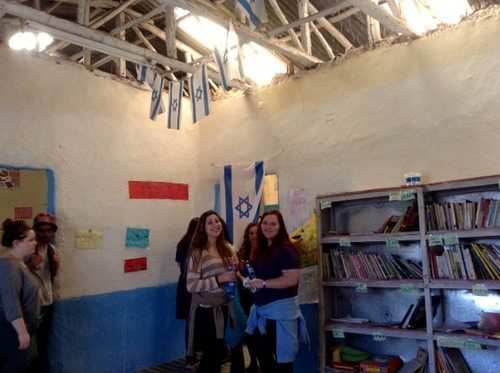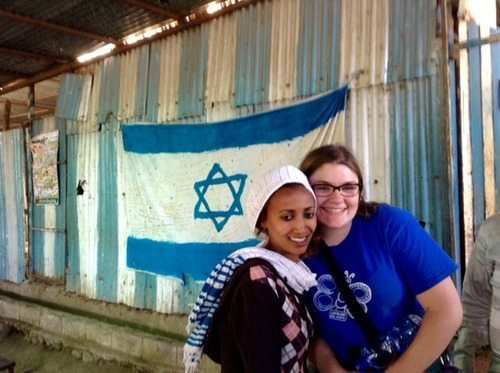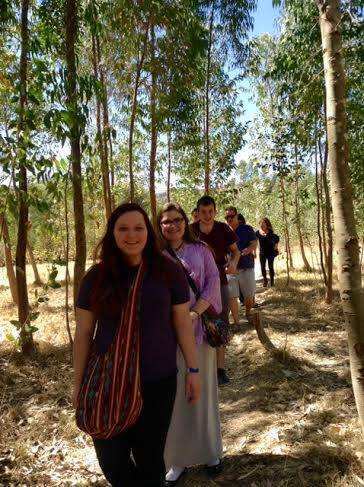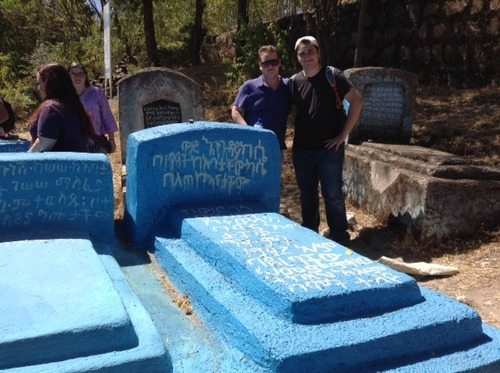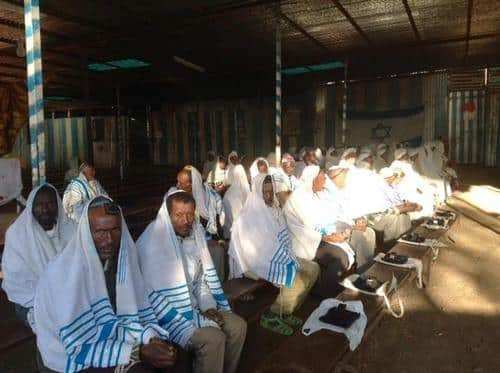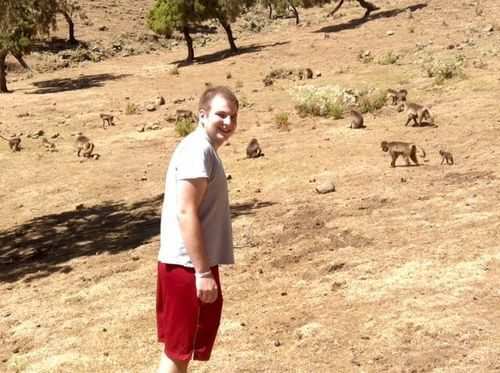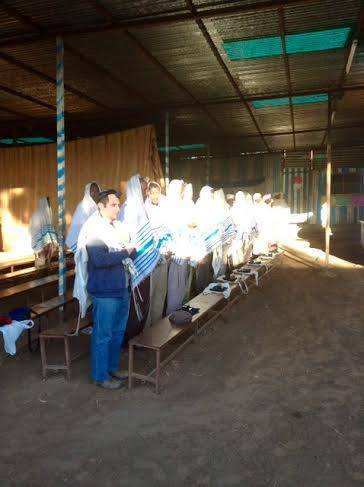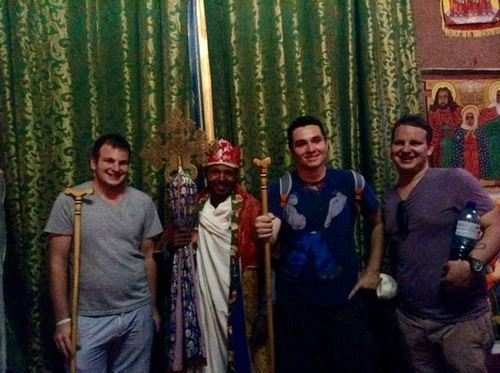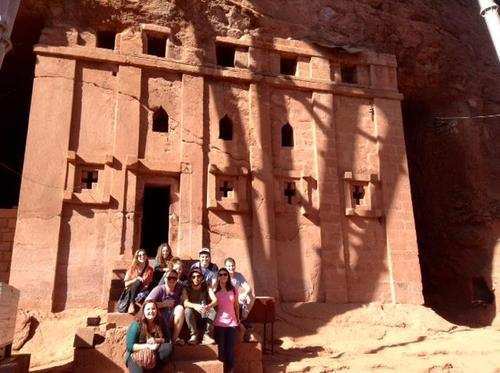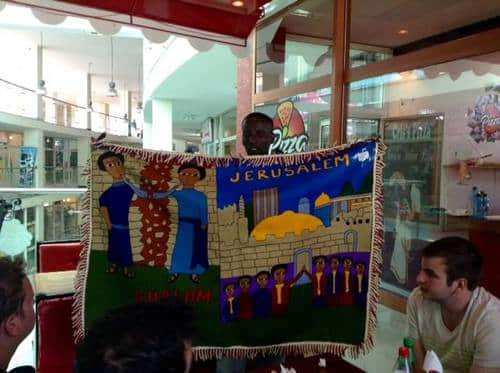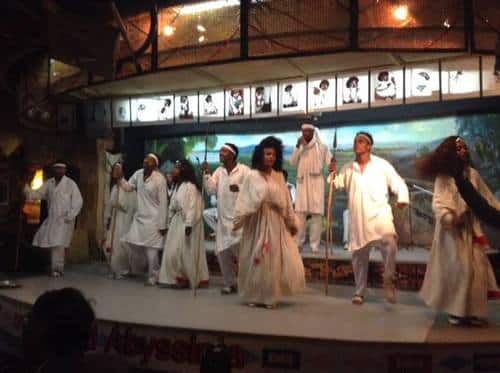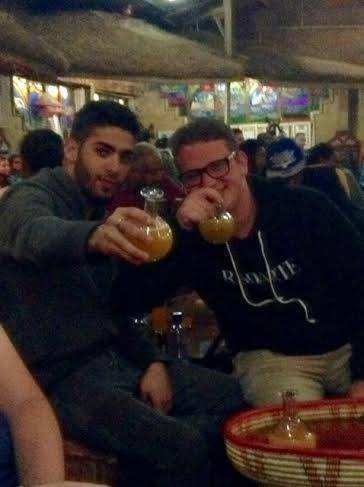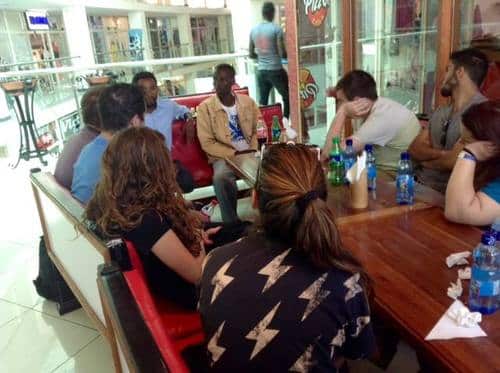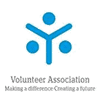Day 1
Today was a day that will live in the memories of your kids for the rest of their lives. We landed in Gondar, a tiny airport in Northern Gondar, met our guide, driver and Dejene Hodes (graduate of the program and now running heritage tours to Ethiopia) and started our journey and the culture shocks started as soon as we left the airport. Just looking out the window at the mud-huts, tuk-tuks, the way people were dressed, the amount of people walking in the middle of nowhere was an extremely eye-opening experience. Our first stop was the Jewish community in Gondar.
The Israeli Government doesn’t recognize them as Jews, even though they almost all have blood relatives living in Israel. They number around 6,000 people and the community is centered around a compound, which includes a synagogue, classrooms, library and a mikveh. We met the head of the community and other people who were hanging around.
They gave us a tour of the complex, interacting with us in Hebrew – how strange it was to be in the heart of Ethiopia and be surrounded by blue and white and Hebrew and Israeli posters of the chaggim and Eretz Yisrael.
They are fairly religious making the girls, cover up their pants with scarves or skirts and the guys covering their heads. They have prayers three times a day and teach everyone Hebrew. We watched a teenage dance class in action, which was a great entry into Ethiopian culture (it was Ethiopian dancing). It set the tone for the trip in a really nice way. They invited us back for Minchah when there would be more people around.
We left and checked into our hotel and then went to the Debre Birhan Trinity Church. It was unique in the amount of Jewish imagery from the Torah that it contained. It was shaped like Noah’s Ark and it was covered in magnificent murals adorning the roof and the walls of the church, depicting scenes from Jesus life but also many stories from the Torah. It was a very different Church than any of us have ever visited before. After that we ate a quick lunch with the option of traditional food for those who wanted it and many people tried their first Injera (EthiopianBread).
After lunch we continued on to Wolleka, a fallasha village just outside Gondar.
There were more Magen David’s in the village than in Israel.
We started off by going to the Cemetery. In order to get there we had to walk through fields and cross a stream and suddenly we were presented with a few of dozens of blue tombstones poking through the trees. We walked around the cemetery, seeing Hebrew mixed with Amharic and blue and white and stars of David everywhere. What an experience!
Then we returned to the village and were surrounded by children and women trying to sell us their wares.
It was a little overwhelming. We stopped in one women’s hut (traditional building, which serves as a home to most people) and talked about the history of Ethiopian Jews and tracing it back to the Queen of Sheba and King Solomon and their son, Menlik 1 and their descendants and their legends about the Ark of the Covenant being in Ethiopia as a gift by King Solomon to his son. Inside and outside the hut there were many mini-sculptures of Solomon and the Queen and their son and the Lion of Judah and Shabbat candlesticks with the Magen David and all sorts of other artifacts for sale, celebrating this story and embracing the Solomonic dynasty, which Ethiopians seems very proud of. We then continued to the Old Synagogue, which is no longer in use and then when to a Women’s commune, set up by a Jewish Ethiopian Woman to help single mothers produce and sell their products.
We saw some traditional weaving and then participated in a coffee ceremony. Some students needed the coffee by then.
We then visited the Royal Enclosure of Gondar, which was the capital city for 200 years and each Emperor built their own castle within the enclosure. We explored the castles, seeing something different in each one and it; stunning architecture and once again, there were Magen David’s everywhere (in the Royal Castles). They were pretty spectacular, plus we got to seeing two wedding celebrations and some live music on a Masinco (a one string violin). Michael was so happy at seeing this, I thought he’d burst.
We then rushed back to the Jewish Compound for Minchah, where about 150-200 people had turned up to daven. (Bigger than my minyan back home).
They started davening and we heard Kaddish and it sounded familiar and then that was it. From that point on we only understood two more words – Amen (which they say a lot) and Israel. The reason we didn’t understand this, despite having gone to very good Jewish Day Schools, was that the rest of the service was led in Amharic. Amazing! Such a unique experience. After Minchah, we handed out candy to all the kids and then we left.
Our last stop was Fasiladas pool, in which pilgrims still take a plunge during the Timket (Epiphany) celebrations. It was a 400 year old pool with a very clever system of recycling its water. Way ahead of its time. By this point, we were starting to crash, so we headed back to the hotel and rested. Our hotel is beautiful. Situated at the top of a hill with wonderful views over Gondar. Abby stayed awake to watch a beautiful sunset and a few us were star gazing this evening.
Finally, we had a traditional evening, which included local Gondar dress, music and dancing, more coffee and Tej, a honey wine/beer drink. It was a lot of fun and brave souls, Benji, Lisa, Yarden and Leah all joined in the with dancing, attempting to move their shoulders in ways that just don’t look realistic. Benji and Lisa even did solos.
Day 2
We started the day with an optional trip to Shacharit (morning prayers) with the Gondar Jewish community. As it was Monday it was Torah reading day, so we got to see them take the Torah out and then read Parsha Yitro in Amharic.
There were well over 100 people at the minyan, at least half of who were women and many were children. To see people with such devotion to the Torah and daven with such Kavanah was a very uplifting experience. I have sent a short clip from when they took the Torah out of the Ark in the e-mail with the photos.
We then continued onto the Semien National Park. The drive itself was part of the experience. Everyone was excited at the prospect of being able to sleep for 3 hours on the way up there, but the journey itself was captivating and nearly everyone stayed awake for the majority of the trip. The views were breathtaking and we got to see how Ethiopian agriculture operates. We drove through towns, villages and countryside. Much of the time we were slaloming our way through people, donkeys, cows, sheep, goats and all manner of other obstacles and 1/3 of the journey was on a dirt road
Eventually we arrived at the National Park, one of the most spectacular landscapes in the world and listed by the UNESCO as a world heritage site. The Semien chain of mountains is the steepest and most precipitous on the continent and is often compared to the Grand Canyon of Arizona. We had a nature walk along the escarpment with a local guide and took in the breathtaking views and saw some of the wildlife, including hundreds of butterflies and the gelada monkey. We all started chasing them to try and get close enough for a great picture. Sam was particularly adamant at trying to get a selfie with them.
Gil settled for a selfie with some cute local kids who were hanging out there. We spent some time watching the monkeys in their natural habitat, interspersed with many farmyard animals. It was a strange thing to see – monkeys, goats, sheep and horses, but it works for them.
Finally we made our way to a lodge for lunch in the middle of the park and then started the journey home. This time everyone fell asleep for the journey home – the hike at a the high altitude (3250 ft about sea level) was quite draining. When we got back to our hotel, most people sat around the pool and relaxed, watching the sunset until dinner. The students have the option to go out tonight for more Ethiopian Dancing but judging by the looks of them, they’ll all just stay here and go to bed.
Day 3
Today we left Gondar and flew to Lalibela. It was the shortest flight any of us had ever taken and we landed almost as soon as we took off. We left the airport and immediately were met with a dramatic landscape, totally different from Gondar. It looked much more like a mountainous, desert landscape and absolutely stunning. We drove up the mountain to the town of Lalibela and checked into our really nice hotel, where we are staying in comfortable, authentic huts with balconies and sweeping views of the valley beneath us and the mountains above us.
We checked in and immediately left to explore the number 1 site in Ethiopia and it’s very easy to see why it’s the number 1.
Civilization of the past is still alive in the form of strange and beautiful monuments and ruins. The 11th century rock hewn churches of Lalibela reveal a marvelous and skillful architectural knowledge of the past. These incredible edifices remain places of living worship to this day and no one visiting here can fail to be stunned and awed by the remarkable human achievements that the churches represent. There are 11 churches in total and they are all built out of one single rock or mountain and connected with underground tunnels and trenches.
We saw a religious ceremony at one point and made our way through one tunnel known as hell without any light whatsoever. We took a million pictures but I am not sure they do the site justice. We met some priests and explored the site in it’s entirety.
It was extremely impressive. In the middle we grabbed some lunch and afterwards we checked out the local souvenir stores. Gil and Michael decided to sit in a cafe and hang with some locals, chatting with them about Ethiopian culture and sharing some drinks with them.
We then cleaned up at our hotel before heading out to watch a stunning sunset at a funky restaurant where we spent the first part of the evening.
The views were incredible, but only Kira had a good enough camera to really take advantage of it. We watched the sunset on one side of the restaurant and then the full moon rise behind the mountains on the other side of the restaurant. The stars came out and we were surrounded by darkness, except for thousands of stars. It was very special.
After this we went to local bar with a Tej ceremony and traditional singing and dancing. We tried different levels of Tej with some sweeter than others and the evening got really amusing as the performers started free-styling in Amharic.
They picked on Michael for a bit and then Yarden and her hair and then started on Leah and developed some sort of obsession with her. At a certain point he offered to swap me a woman of my choice for Leah and at the end of the evening, followed us out the bar and serenaded her in English. Leah also danced a bit, but Benji really showed everyone how it was done. We laughed a lot and had a great evening.
Tomorrow we continue to Addis Ababa.
Day 4
We flew into Addis Ababa this morning and began to discover the city. Founded in 1886 by Menelik II, Addis Ababa in Amharic means “new flower,” and it is a giant city full of people everywhere you look. It was the closest we have been to civilization since we have been here, but still 90% of the roads are no more than dirt paths and they are in serious need of some traffic lights, especially at one intersection where there are 5 busy roads converging. It was a mess! We sat in a lot of traffic today. “This is Africa” became a popular saying today.
Our first stop was lunch in a modern day mall. After lunch we met with Yihune Liwateh, who is a member of the Beta Abraham community in Addis Ababa.
They are also Falashas, not recognized by everybody as Jewish and not halachically Jewish, but practicing Orthodox Judaism. They believe they are Jewish and want to make Aliyah. He talked about his childhood and his uncle teaching him about all the Jewish rituals. He moved to Addis 15 years ago, but missed the major wave of Aliyah and has been stuck here ever since, waiting for Israel to let him come. He has a brother and sister living in Ashdod. He says his best hope is that he qualifies under the ‘family reunification law’. He keeps Shabbat and festivals and goes to Shul to daven every morning. It was very interesting. After his personal story, he told us about the handicrafts his community is famous for and then he showed us some of his embroidery work. All his work were based on scenes from the Torah and they were beautiful.
We then continued onto the National Museum of Ethiopia. When we got there, there was a power cut (this is Africa) so the museum was in darkness, but that didn’t deter us or our guide. With the help of natural light, she showed us around the whole museum. It was like a crash course in Ethiopian history and culture. Again there was a focus on he Ethiopian connection to king Solomon and the Jewish people. She claimed a lot of Ethiopians could trace their heritage to the Jews. She didn’t know we were a Jewish group when she was telling us this. This claim was reflected in much of the art we saw in the museum. We then went to the highlight of the museum, the skeleton of Lucy, which the museum is famous for. Supposedly it’s the oldest known humanoid skeleton at 3.2 million years old. The skeleton was in the basement, which was pitch black so we all used the flashlights on our phones to illuminate the exhibit. It was like something out of a movie. Lisa was particularly excited to meet Lucy, although once down there, we also saw skeletons from 3.3 and 4 million years ago.
After the museum, it was finally time to try out our bartering skills and so off we went souvenir hunting. We spent time shopping for gifts for family members and then headed to our hotel to check in. We drove up Mount Entoto, with stunning views of Addis below and found our beautiful hotel in the middle of a forest. We got ready for the evening and headed out for an evening of traditional entertainment. The show we saw celebrated the different regions and tribes of Ethiopia by showcasing costumes, instruments, songs and dances from each of them.
Again it was a very special night which ended with a Tej and then a coffee ceremony, which gave us all the extra spurt of energy we needed to go clubbing in Addis Ababa.
We were joined by our tour guides and some of Dejene’s brothers too, so it was another authentic experience with locals. Tomorrow, is our last day and includes a trip to the Israeli Embassy and another chance to shop, before heading to the airport to catch our flight home.
Day 5
Today was our final day. After a late night, where we took over an Addis club and mingled with locals and even met Miss Africa America 2013-4, we had a relatively leisurely morning in our hotel.
Then we braved the Addis traffic again and headed to the Israeli Embassy. The Embassy is a huge complex, that you can spot from miles away as it’s outside walls our painted blue and white. The head of security even gave us a tour of the grounds. We then met the Ambassador, Belyanesh Zevadia, who is the first Ethiopian-Israeli diplomat to represent Israel in any of its missions. She is also the first Ambassador from any country in the world to have been born in Ethiopia and to return there as its nations representative.
She told us her personal story (her Dad was Chief Rabbi of Ethiopia) and talked about Israel’s relationship withEthiopia, including the Mashav projects. Mashav is Israel’s Agency for International Development Cooperation in the Ministry of Foreign Affairs. Mashav is responsible for the design, coordination and implementation of the Israel’s worldwide development and cooperation programs in developing countries. MASHAV believes that its greatest possible contribution to developing countries can be made in fields where Israel has relevant expertise accumulated during its own development experience as a young country facing similar challenges. Israel has 8 successful agricultural projects in Ethiopia making a huge difference, so much so that the Ethiopian Government has asked them to expand it to 80 projects. She also talked about Israel’s relationship with the remaining felasha, which she said is a mess and is glad she is not responsible for making the decisions. She also represents Israel in Rwanda and Burundi and talked about how important that was during the recent summer conflict with Gaza, when Rwanda was chairing the security council. She was very friendly and amiable and it was a very interesting discussion with her. Michael asked the best question about what she thought the hardest challenge for Ethiopians to overcome when they make Aliya to Israel and she responded – EDUCATION.
We then had a short amount of time for some more last minute souvenir shopping and then after lunch we made a quick stop to an authentic coffee house, owned by the Mother of one of our Tour Operators, Abi. We had a short coffee ceremony there in the middle of an Addis neighborhood – not many tourists get to do that. Finally, we headed back to the airport to fly home, which is where I am writing to you from. It was a pleasure taking your kids, only a few of who stayed healthy for the entire trip. However, despite being ill at various points, everyone soldiered through making the most of this wonderful opportunity you have given to them.




